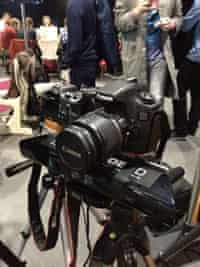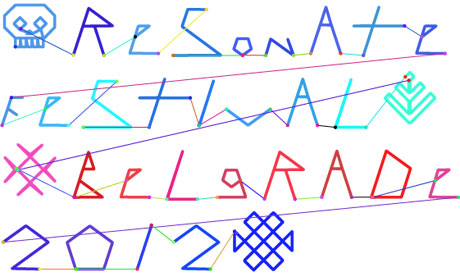For two days last weekend, Belgrade played host to the inaugural Resonate festival, a new media event gathering together artists, programmers, and assorted types from the creative and technology industries.
Trading insights - often late into the night - were code artists, designers (graphic, interaction and otherwise), film-makers, programmers of all persuasions, visualization folk, creative technologists, and others - all brought together by the vision of Maria Jelesijević, a Belgrade-based visual artist, and Filip Visnjic, editor-in-chief of the Creative Applications Network.
As indicative as anything of the nature of Resonate was the frequency with which speakers began talks with gambits like: “I’m not really sure how to introduce myself, because my work kind of…falls in between categories.”
Jer Thorp, data artist in residence at the New York Times, had a humble take on this when he said he often felt in a position of ‘extreme mediocrity’ when it came to the practice of any one of the skills involved in his work.
Audiences were taken on journeys, from discipline X to Y, sometimes detouring into Z, by professionals whose entire modus has been to work in the gaps between. An enormous and hugely varied body of work was presented of which I can only begin to give a taste.
Jürg Lehni spoke about Paper.js, on open-source, vector graphics scripting framework running on top of HTML 5 canvas that he developed with his partner Jonathan Puckey, an Amsterdam-based designer. He also spoke about his other work, not least his now well-known drawing machine ‘Hector’, which uses a script - and a series of pulleys, levers and string - to program the movements, and sprays, of a can of paint.
Josh Nimoy, a West Coast-based code artist, talked the crowd through some 30 years of art production, from his earliest paintings as a kid, through the stunning visuals he produced alongside Bradley Munkowitz for the recent Tron film. He also gave one of the more memorable descriptions of the thing clients seemed to want when they asked for his fancy visuals, namely: “Sexy bullshit.”
Jonathan Puckey presented the ‘Conditional Design manifesto’, an attempt to define an approach to design - regardless of ‘chosen media’ - as a reaction to a world where computation, or computational processes, are increasingly prevalent. (One of the principles is a questioning of the use of random functions: ‘Avoid arbitrary randomness. Difference should have a reason.’)
Jer Thorp gave an introduction to Open Paths, a place where users can upload, securely store and make use of personal location information gathered by their mobile devices. It was designed, he said, to return to users the power to understand and use their data in a world where that data is largely collected for the exclusive use of corporations.
Separate to the talks were a suite of workshops where participants got a more ‘hands-on’ experience of various technologies.

One of the best-attended was one about a new framework called ‘RGB+Depth’, where a Kinect device is attached to a high-definition camera, thereby adding a depth component to filming. This generated a lot of attention. Film-makers, such as the Berlin-based Gabriel Shalom recognised the potential of a world where, instead of just frames, what directors are effectively capturing in shooting is a ‘point cloud’, enabling them to experiment with the creation of ‘virtual cameras’ in post-production.
Other workshops talked participants through the use of libraries to assist computational design tasks (Karsten Schmidt), programming visual effects (by Andreas Mueller, of Nanika), digital stereoscoping (Richard Difford and Anne-Laure Guiot), and, popularly, Niklas Roy’s beguiling ‘Electronic Instant Camera’.
Great festivals don’t have ‘themes’ - the best assemble interested folk and hopefully allow them to exchange ideas. (Big tick to Resonate on that front.) But if there was a motif that ran through the festival - whether in the talks, workshops, or interstitial conversations, it was this: that if this is an age when computation affects pretty much everything - not least design, then there seems to be a strong theme emerging around how ‘a human element’ can join in that affectation.
This can often manifest itself as a concern for instances where humanity is absent, as evidenced by Jer Thorp’s quote (in a data context) that “we’ve ignored the human context of systems”, and Jürg Lehni’s (in a software tool context) that “there is great promise in combining manual and combinatorial ways of work.”
There was a simultaneous recognition that computers have given rise to different kinds of human behaviour, often in unexpected ways. Field, for instance, a London-based agency, remarked that “by adding features to a system, you create possibilities”, citing the example of a new style of make-up - consisting of large, black and white triangles on the cheeks - which allows the wearer to avoid detection by facial recognition systems.
Overall, a brilliant and inspiring event. We’re hoping it returns in 2013.
